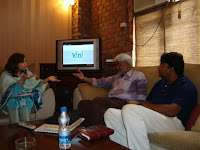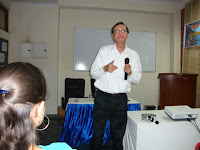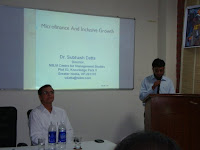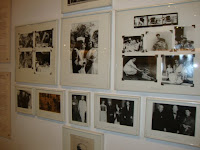

We had an announcement on 30th July-2010 that Sat day and Sunday will be off from in house training sessions and all the teams would have educational and historical sightseeing.
The day begun with heavy rain in Faridabad and Delhi peripheries, however the bus headed towards Lal Qilah slowly.
We all came to Lal Fort and had quick visit of this historical place.
The Red Fort in urdu: لال قلعہ , usually transcribed into English as Lal Qil'ah or Lal Qila) is a 17th century fort complex constructed by the Mughal emperor Shah Jahan in the walled city of Old Delhi (in present day Delhi, India). It served as the capital of the Mughals until 1857, when Mughal emperor Bahadur Shah Zafar was exiled by the British Indian government. The British used it as a military camp until India was made independent in 1947. It is now a popular tourist site, as well as a powerful symbol of India's sovereignty: the Prime Minister of India raises the flag of India on the ramparts of the Lahori Gate of the fort complex every year on Independence Day.


Having finished the visit at Lal Qila, the team was divided in some groups so that sightseeing could be prioritized with consensus.
We in a team Mr. Shafqat Chaudhary and I headed towards a holy place of Sultan-ul-Mashaikh, Mehboob-e-Ilahi, Hazrat Shaikh Khwaja Syed Muhammad Nizamuddin Auliya (1238 - 3 April 1325) (Urdu: حضرت شیخ خواجة سیّد محمد نظام الدّین اولیاء) shrine, also known as Hazrat Nizamuddin, who was a famous Sufi saint of the Chishti order in South Asia, an order that believed in drawing close to God through renunciation of the world and service to humanity. He is one of the great saints of the Chishti order in India. His predecessors were Moinuddin Chishti, Bakhtiyar Kaki and Fariduddin Ganjshakar. In that sequence, they constitute the initial spiritual chain or silsila of the Chisti order, which is widely prevalent in India and Pakistan.
Nizamuddin Auliya like his predecessors stressed upon the element of love as a means of realisation of God. For him his love of God implied a love of humanity. His vision of the world was marked by a highly evolved sense of secularity and kindness. It is claimed by the 14th century historiographer Ziauddin Barani that his influence on the Muslims of Delhi was such that a paradigm shift was effected in their outlook towards worldly matters. People began to be inclined towards mysticism and prayers and remaining aloof from the world.
Then we both moved towards the shrine of Ameer Khusrau Dehlavi (1253-1325 AD), a prolific classical poet associated with royal courts of more than seven rulers of Delhi Sultanate, is also a household name in much of North India and Pakistan, through hundreds of playful riddles, songs and legends attributed to him. Through his enormous literary output and the legendary folk personality, Khusrau represents one of the first (recorded) Indian personages with a true multi-cultural or pluralistic identity.



Without loosing time, we both rushed to visit Mirza Ghalib's Tomb in Delhi whose real name is Mirza Asadullah Khan Ghalib, the legendary Urdu poet of Delhi, buried under it. The tomb in Delhi was designed by the famous architect of Hyderabad, Nawab Jang Bahadur. Located in Nizamuddin area, this tomb lies next to Hazrat Nizamuddin's Mazaar and north of the enclosure of Chaunsath Khamba. An academy was established nearby later in 1969 to perpetuate his memory and works. The greatest Urdu poet of the nineteenth century, he was a great writer of ghazals and a friend of the Mughal Emperor Bahadur Shah 'Zafar' . He was also appointed as the teacher of Bahadur Shah II.
The grave in Mirza Ghalib's Tomb in Delhi is covered by a small marble structure and enclosed within a compound wall.
The courtyard, which surrounds the grave in Mirza Ghalib's Tomb in Delhi, is always locked. Guess why? So that gate-crashers and intruders can be kept away from the serene and pure ambience of the place.




After visiting the tomb of Mirza Ghalib we both Shafqat and I planned to have food some where nearby to Delhi Jamia Masjid preferably Al Karim Hotel. Finally we were able to reach at AlKarim Hotel and had delicious food and then headed towards red temple called as Shri Digambar Jain Lal Mandir which is an oldest and best known Jain temple in Delhi India. It is directly across from the Laal Quila in the historical Chandni Chowk area.
It is known for an avian veterinary hospital (bird hospital) in a second building behind the main temple.
Located just opposite the massive Red Fort at the intersection of Netaji Subhas Marg and Chandni Chowk, Digambar, Jain Temple is the oldest temple of the Jain religion in the capital, originally built in 1656. An impressive red sandstone temple today (the temple has undergone many alterations and additions in the past and was enlarged in the early 19th century), the Digambar Jain Temple is popularly known as Lal Mandir.
After visiting Lal Mandir we both came back to Meadow, Global school of management hostel.

































